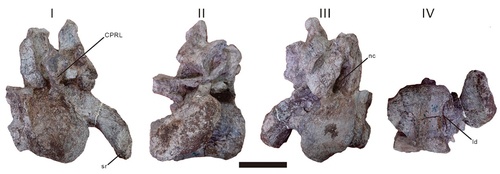MEANING: Jing
PERIOD: Late Jurassic
CONTINENT: Asia
Jingiella is a mamenchisaurid sauropod dinosaur from the Late Jurassic Dongxing Formation of Guangxi, China. The name honors people of the Jing Nationality. Mamenchisaurids are known not only for being generally large dinosaurs, but for their necks being among the longest in proportion to body-length, even compared to other sauropods. Like all sauropods, Jingiella walked on four pillar-like legs and subsisted on a herbivorous diet.

Abstract from paper: A new mamenchisaurid sauropod dinosaur, Jingia dongxingensis gen. et sp. nov. from the Upper Jurassic of Southernmost China is reported here. The holotype consists of partly preserved dorsal, sacral, and caudal vertebrae, left and right ulna, and right femur. Anatomical comparison and phylogenetic analysis indicate that the new taxon belongs to Mamenchisauridae and bears a unique combination of characteristics, such as the ratio of the length of the neural spine to the narrowest width of the neural arch of the dorsal vertebra is about 4.4; sacral centrum is opisthocoelous with shallow depression exists on the lateral surface; centrum of anterior caudal vertebrae are amphicoelous, and the articular surfaces are transversely compressed; the anterolateral and anteromedial processes of the ulna are generally perpendicular in proximal view. Phylogenetically, Jingia dongxingensis gen. et sp. nov. is located at the later diverged position in Mamenchisauridae. This discovery increases the diversity of Mamenchisauridae and provides additional information to help understand the evolutionary radiation of eusauropods in China. It also indicates that this lineage is more competitive than penecontemporaneous neosauropods to dominate the Late Jurassic of East Asia.
Jingiella is from the Jurassic. The Jurassic is a geologic period that spanned from the end of the Triassic, 201 million y ears ago, to the beginning of the Cretaceous, 145 million years ago. It is the middle period of the Mesozoic Era. The start of the Jurassic was marked by the major Triassic-Jurassic extinction event. The end, however, has no clear boundary with the Cretaceous. By the beginning of the Jurassic, Pangea had begun rifting into two landmasses: Laurasia and Gondwana, and the climate was warm with no ice caps. Life on land was dominated by dinosaurs, and the first birds appeared, evolving from a branch of theropods. The oceans were inhabited by marine reptiles, while pterosaurs were the dominant flying vertebrates.
Jingiella is a sauropod. Sauropods are saurischian dinosaurs that had very long necks, long tails, small heads (relative to the rest of their body), and four thick, pillar-like legs. They are notable for the enormous sizes attained by some species, and the group includes the largest animals to have ever lived on land. Well-known genera include Brachiosaurus, Diplodocus, Apatosaurus and Brontosaurus.
The oldest known unequivocal sauropod dinosaurs are known from the Early Jurassic, and by the Late Jurassic (150 million years ago), sauropods had become widespread. By the Late Cretaceous, one group of sauropods, the titanosaurs, had replaced all others and had a near-global distribution. This group included the largest animals ever to walk the earth. Estimates vary, but the largest titanosaurs are estimated at upward of around 40 m, and weighing 100 t, or possibly even more.
As with all other non-avian dinosaurs alive at the time, the titanosaurs died out in the Cretaceous–Paleogene extinction event. Fossilized remains of sauropods have been found on every continent, including Antarctica.








